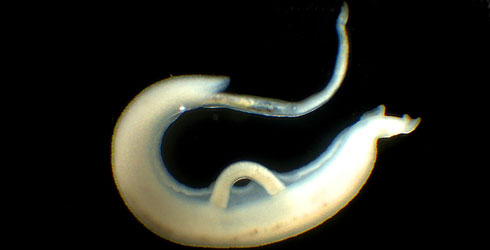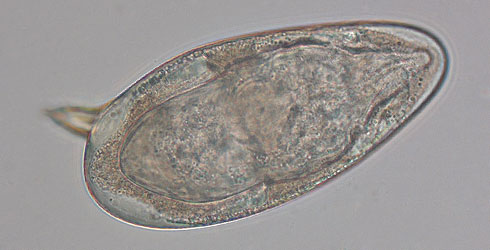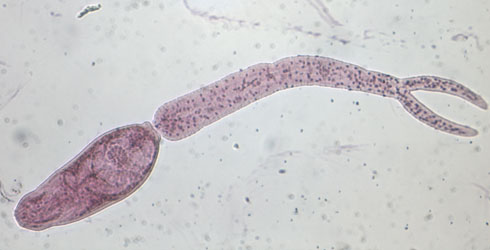Schistosoma mansoni (trematode flatworm)
Schistosoma mansoni is a trematode flatworm, one of a number of species of schistosome causing the parasitic disease schistosomiasis, or Bilharzia. Schistosomiasis affects over 200 million people worldwide.
- Urinary schistosomiasis - parasites progressively damaging the bladder, ureters and kidneys.
- Intestinal schistosomiasis - parasites progressively enlarging the liver and spleen, damaging the intestine and causing hypertension of the abdominal blood vessels.
Drug treatment, snail control, improved sanitation and health education are being used to try and control schistosomiasis.
Species detail
Larval forms of Schistosoma mansoni penetrate human skin and develop into adult schistosomes living in blood vessels surrounding the human intestine.
The male and female form a reproductive pair, with the female held by the male within a groove. Females release eggs, into the blood vessels which are
- passed out of the body in the urine or faeces
- trapped in body tissues, causing an immune reaction
A pair may live for years within the host, the female producing thousands of eggs.
-

Lifecycle
The Schistosoma mansoni reproductive pair can live for several years within their host. Find out more about the lifecycle of this parasitic organism, from the laying their eggs through to the stage where Schistosoma mansoni can infect humans.
-

Distribution
Discover the regions of the world that this parasitic organism can be found in.
-

Disease
Read about schistosomiasis, how it can result from Schistosoma mansoni, the process by which it develops and how it is treated.
-

References
Get reference material for Schistosoma mansoni.
Global distribution
A map showing the world-wide distribution of schistosomiasis.

A map showing the global distribution of schistosomiasis the disease caused by
Schistosoma mansoni. © CDC http://wwwnc.cdc.gov/
Video
Miracidium hatching from a Schistosoma mansoni egg in fresh water.
Mature adult Schistosoma mansoni release eggs, into the blood vessels.
Eggs are
- passed out through the wall of the host's intestine.
- circulating in the blood cause much of the pathology associated with schistosomiasis, as they become trapped in the liver and other internal organs.
The eggs in the intestine pass out of the body with faeces and if they come into contact with fresh water, hatch into a free-living life-cycle stage called the miracidium.
You need to download the latest Flash Player to view this video. Visit the website to download the Flash Player
Images

A Schistosoma mansoni male/female pair. The female is held by the male in a groove along its body.

Schistosoma mansoni egg. The egg has a characteristic lateral spine. The miracidium stage can be seen within the egg. © A Emery

The miracidium is a short-lived free-swimming stage of Schistosoma mansoni that infects snails. © A Emery

S. mansoni miracidia infect freshwater snails, which eventually leads to the cercaria, the stage that infects humans

The cercaria is the life-cycle stage of Schistosoma mansoni infecting humans. © A Emery
About the author

Dr Aidan Emery
Schistosome researcher and Culture Facility Laboratory Manager, responsible for molecular collections development.
Toolbox
Museum research

Tackling schistosomiasis
Our scientists are involved in researching the ways schistosomiasis is transmitted and treatment programmes to help those in affected regions.
